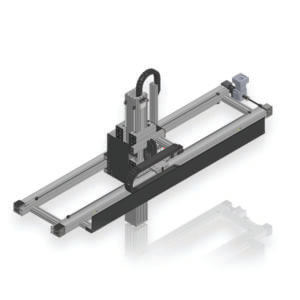Job Stories
Learn the benefits of using Linear Robotics and how a linear robot can be more economical than other types of robots such as articulated arm or SCARA.
 With automation on the rise, the case for linear robotics, has expanded. Linear robots are a type of industrial robot with two or three principal axes that move in a straight line rather than rotate, functioning at right angles to each-other. The three sliding joints correspond to moving the wrist; up and down, back and forth, as well as in and out. Linear robots with horizontal members supported at both ends are referred to as Gantry robots.
With automation on the rise, the case for linear robotics, has expanded. Linear robots are a type of industrial robot with two or three principal axes that move in a straight line rather than rotate, functioning at right angles to each-other. The three sliding joints correspond to moving the wrist; up and down, back and forth, as well as in and out. Linear robots with horizontal members supported at both ends are referred to as Gantry robots.
Because there are no rotating axes, linear robotics tend to have a higher degree of accuracy, making them the ideal automation solution for those mundane repetitive tasks. Unlike other automation machines, linear robotics systems can be reprogrammed to accommodate product changes quickly, and are flexible to meet unique requirements. A linear robot can be more economical than other types of robots such as articulated arm or SCARA.
Many industries today require automated processes to ensure process repeatability, reduce variability, meet quality expectations and lower manufacturing costs. Automation is vital to many companies to meet lead-time demands and remain competitive. Robotic systems offer the best cost investment as they can be reprogrammed or repurposed to meet product variety and life cycles. Linear robotics are a versatile solutions for these challenges.
There are many different uses for Linear robotics, but the most common are:
Multi-Axis
Explore how Macron Dynamics engineered a water resistant, belt drive actuator for a Smart Engineering Solutions company for educational use...
Multi-Axis
In search of an automated solution to increase productivity and decrease safety hazards, OES Automation worked with Macron Dynamics to...
Multi-Axis
Explore how Macron Dynamics used an X/Z Heavy Duty Gantry System for a beverage industry customer’s pick and place packaging...